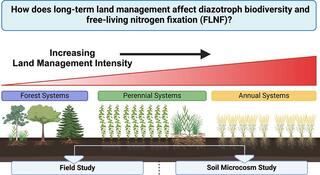Reduced soil diazotroph diversity decreases nitrogen fixation rates but depends on land management
B. Kristy et al. "Reduced soil diazotroph diversity decreases nitrogen fixation rates but depends on land management" Applied Soil Ecology 211:106152 [DOI:10.1016/j.apsoil.2025.106152]
Soil diazotrophs convert atmospheric nitrogen into plant-available ammonium through free-living nitrogen fixation (FLNF). This sustainable nitrogen source can reduce our dependence on synthetic fertilizer inputs in conventional agricultural systems. However, we know little about the effect of diazotroph diversity on FLNF, especially given that FLNF is intermediate within the broad-narrow functional spectrum. Here, we determined how management-mediated shifts in diazotroph diversity would impact their ecosystem function (FLNF) by quantifying diazotroph diversity across a long-term management gradient during and after the growing season. In addition to field observations, we leveraged the same management gradient to manipulate diversity in soil microcosms via chloroform fumigation exposure. In the field, diazotroph diversity was significantly higher after the growing season, and the biologically-based annual cropping system harbored the highest diazotroph diversity. However, perennial cropping systems maintained the highest FLNF despite lower diazotroph diversity, and both soil moisture and temperature were stronger predictors of FLNF. Based on these results, integrating diverse perennial crops into agricultural landscape could result in greater N from FLNF, particularly at the end of the growing season. When we reduced biodiversity in a manipulation experiment, the diversity-FLNF association was stronger than in the field experiment, suggesting that FLNF communities are not as functionally redundant as taxonomically ‘broad’ ecosystem functions. The strength of diversity-FLNF correlation varied by previous land management. Diazotroph diversity better predicted FLNF in annual and forest soil microcosms, and microbial biomass carbon better predicted FLNF in perennial soil microcosms. Taken together, our results show that while diazotroph diversity influences FLNF, especially under extreme environmental disturbances, abiotic factors like soil moisture and temperature are stronger constraints on FLNF in the field.
The data presented in this study is available on the NCBI Sequence Read Archive PRJNA1036258. All relevant metadata, data tables, R code, and sequence processing shell scripts can be found at https://github.com/B-Kristy/LTER-MCSE-Analysis.
